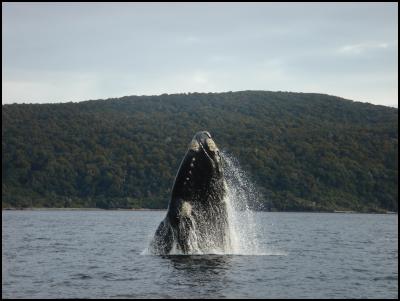Look out for endangered southern right whales
19 May 2009
Keep an eye out for endangered southern
right whales

Click for big version
Preservation Inlet, Fiordland - 29 July 2007. Photo: Don Goodhue
The Department of Conservation (DOC) is calling on the public to keep an eye out and report sightings of southern right whales which are starting to move along the New Zealand coastline.
Recent sightings of whales near Dunedin, and one near Stewart Island, has signalled the start of this year’s whale migration season and the beginning of the Department of Conservation’s southern right whale research programme.
“This is exciting – it’s a rare opportunity for members of the public to see large whales from the coast and to help DOC with crucial research” said Steve Smith, DOC’s national marine mammal coordinator.
DOC’s challenge is to find as many whales as possible and do more research to better understand the relationship between the whales seen around the mainland and those from the New Zealand sub Antarctic region. Whale sightings help DOC researchers retrieve tissue samples and other vital information. DOC needs to collect genetic samples from 30 individual right whales but at present we only have 22.
The purpose of DOC’s research is to learn as much about endangered southern right whales as possible and then take measures to ensure the whales have the right level of protection.
Since May of 2003 an average of 70 southern right whale sightings have been reported each season. “Hopefully with the public’s continued help we will be able to complete our research by the end of the year,” said Mr. Smith.
Any southern right whale sightings should be reported immediately on the Doc hotline, 0800 DOCHOT (0800 36 24 68).
Additional background
information
The whales were hunted extensively along the coasts of New Zealand from the beginning of the 19th century. The current population is estimated at less than 5% of its pre-exploitation size.
These slow travelling, coastal whales were once so abundant in New Zealand waters that early settlers in Wellington complained that the noise of their blowing kept them awake at night! Though by 1936, when they became protected, they were on the verge of extinction.
They are called southern right whales for the wrong reasons – named by early whalers because they are slow moving, were easily hunted, float when dead and provided large quantities of valuable oil and whalebone. They were therefore the ‘right’ whale to hunt!!
What they get up to
Southern right whales spend a large portion of their winter breeding months (June – September) very close to the shore in sheltered waters, sometimes resting on the bottom with their blowholes above the surface.
Southern right whales spend the summer months feasting on small crustaceans in the waters north of Antarctica. In the winter and spring some of these whales move up to their breeding grounds near New Zealand’s subantarctic Islands. Small numbers of southern right whales are also sighted around mainland New Zealand. The New Zealand population is estimated at less than 5% of its original size.
A recent report has found that the stocks of southern right whales in New Zealand waters, Eastern Australia, and South Western Australia are separate populations. Continuing to sample mainland southern right whales in New Zealand will help us to understand whether individuals are moving between the two areas.
What to look for
Adult southern right whales average 14.5m long, and newborn calves, between 4.5m and 6m. They are mostly black in colour and can be identified by their lack of a dorsal fin, a V-shaped blowhole spray, and white growths on their heads called callosities. Each whale has a unique callosity pattern.
What to do if you see a southern right whale
Southern right whale sightings should be reported to DOC, preferably as soon as possible after the sighting is made, on 0800 DOCHOT line (0800 36 24 68). DOC needs to know the date, time and location of the sighting; the number of whales; whether there were any calves; and their direction of travel.
Photos help identify individual whales, especially those of the left side of the head to compare callosity patterns, and of the full body length.
Whales should be approached slowly, quietly and cautiously, and no closer than 50m, preferably from behind or parallel to them. Boaties are requested not to obstruct their path, cut through a group or separate mothers from calves, and to turn off their engines if a whale approaches their vessel. Making sudden noises may startle the animals and should be avoided. Aircraft should keep a 150m distance from whales and not fly directly over them.
Find out more about the southern right whale on the DOC website: www.doc.govt.nz/conservation>native animals>marine mammals>whales
ENDS


 Gordon Campbell: On The Making Of King Donald
Gordon Campbell: On The Making Of King Donald The Reserve Bank of New Zealand: Statement from RBNZ chair Neil Quigley about OIAs on Adrian Orr's resignation
The Reserve Bank of New Zealand: Statement from RBNZ chair Neil Quigley about OIAs on Adrian Orr's resignation Deep Sea Conservation Coalition: Protected Corals Destroyed In Six-Tonne Bycatch “Disaster” From A Single Bottom Trawl
Deep Sea Conservation Coalition: Protected Corals Destroyed In Six-Tonne Bycatch “Disaster” From A Single Bottom Trawl Aroturuki Tamariki: Report On Outcomes For Tamariki And Rangatahi Māori In The Oranga Tamariki System – A Story Of Consequence
Aroturuki Tamariki: Report On Outcomes For Tamariki And Rangatahi Māori In The Oranga Tamariki System – A Story Of Consequence Fire and Emergency NZ: Unsafe Driver Behaviour Putting Firefighters At Risk
Fire and Emergency NZ: Unsafe Driver Behaviour Putting Firefighters At Risk Andrew Little: Andrew Little Commits To Pay Equity For WCC Library Assistants
Andrew Little: Andrew Little Commits To Pay Equity For WCC Library Assistants PSA: Withdrawal Of Suspension Of Disability Workers At Te Roopu Taurima Welcomed
PSA: Withdrawal Of Suspension Of Disability Workers At Te Roopu Taurima Welcomed


